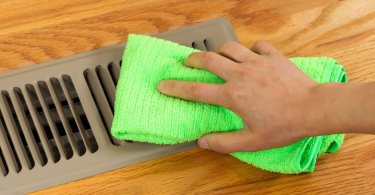The garage is a multipurpose area of the house. It is typically used for more than just parking a vehicle. It can also become your workshop, office, and library from time to time.
Some owners don’t give much thought to insulation and heating in the garage. This is perfectly fine in the summer, but during the fall and winter, the story is different. For homeowners who have considered adding heat to their garage, there may be resistance to installing heat as it is an additional cost.
Today, we will suggest a number of ways to heat your garage for free. You will only need to make a small initial investment, whereby continued usage will be practically free. We will also tell you how you can retain the heat in your garage. Let’s get started!

What Range of Heat to Use For a Garage
Figuring out the correct heating range for your garage is a simple mathematical calculation. For each square foot of your garage, you will need 10W of heat.
Suppose you have a 200 sq. foot garage, then you will need 2,000W of heat. This calculation is dependent on many factors, such as whether you have any open windows and the insulation conditions in your garage.
However, you will need roughly this amount of heat if your garage has normal ventilation openings. The mathematical calculation is only to help you make a correct decision. It is more like a rule of thumb that you can follow.
Now that you know the heating requirements for your garage, let’s discuss how you can fulfill your heating needs.
Before You Begin: Insulation
Heating solutions will be much better if your garage is insulated. Without insulation, even the best garage heater might end up only temporarily warming the garage, and worse, it might not be very effective at all.
Insulation is a great way to ensure heat retention in your garage. It has no running costs that you have to bear. You can save heat from escaping your garage.
If you have a detached garage, you should insulate every side to ensure minimum heat loss. But, apart from walls, heat also escapes from roofs, doors, and even the floor. Let’s see how you can insulate all of these.
Door Insulation
We are starting with the door first because one might forget the door while insulating. Garage doors may end up taking up an entire wall of your garage, so it is very important to keep them insulated so as to prevent heat from leaking out.
Garage doors are often made from steel, which is a poor insulator. You can get an insulation kit from Amazon to do the insulation work of the garage door by yourself.
If you have a garage door of any other material, you can easily get the insulating kit for that as well. Most of these kits are easy to install on your own; you will not need professional help to install an insulation kit.
Roof Insulation
Garage roofs are the worst in terms of heat loss. If you have a metal roof, you will lose heat more extensively. Metal is an excellent conductor of electricity, and when you use a heater, the roof radiates heat outside.
To prevent heat loss, you should install cellulose or foam insulators on your roofs. These are easy to install and are less expensive than other options in the market.

Floor Insulation
Floor insulation is another important aspect of garage insulation. The floor gets colder in winters and can eat up a lot of heat. Concrete is known to be extremely cold during winters. It would be best to put insulation panels before placing the concrete slab in the ground.
The insulation panels should remain between the concrete slab and grade base. It would be best to keep the insulation panels directly in contact with slabs to make them more effective.
Wall Insulation
If you already have drywall in the garage, your garage is probably already insulated. If you don’t, the first thing to do is to check for damaged weather stripping and replace it.
Once you are convinced that you have plugged even the smallest of holes (sometimes insects can create really tiny ones, so do be diligent in your search), you can install blankets on the walls to keep the heat inside. This is the most cost-effective and easiest way to insulate.
Ways to Heat a Garage For Free
Coloring Solutions
This is another simple, effective, and free way of getting heat in your garage. This works best if you have a detached garage that gets ample sunlight. You don’t need to set up a solar panel, but you will want to paint the roof and doors either black, Prussian blue or storm grey.
These colors absorb more heat from sunlight and transfer it into your garage. It is a free way of getting more heat in your garage without needing a heating device. Your roofs and doors will also get insulation as the surface paint will not let much heat escape from your garage.
Solar Panels
This is another simple and long-term method for the heating requirements of your garage. This method works best if you have a separate garage. Yes, there are some considerable initial costs associated with solar panels. But, it is the most feasible option to choose for long-term requirements.
The federal government can provide you with tax benefits if you use a solar device in your home. You can save almost 600$ per year after installing a 3 kW solar plant. Your system will generate up to 4000kWh of electricity in a year.

If your garage has enough roof area, you can install 10-12 panels on the roof to cover a 200-240 sq foot area. The return on investment of a solar panel system is 10-30%.
The system will pay you back 7 to 10 years down the line. A complete solar panel setup will consist of:
- Solar panel
- Panel mounting
- Inverter
- Monitoring system
- Storage batteries
A standard garage will require 4 kW of power for heating. That means you will have free heating electricity for 1,000 hours in a year. The amount of electricity would be enough to heat your garage for 6 hours daily for five months, which is more than enough. Solar power is not only vogue, but it is the future of humanity.
Propane Garage Heater
Propane is generally a cheaper source than electricity. It can deliver the same amount of BTU at a lesser price than electricity. When you look at the costs of the department of energy, the price of propane is almost half of electricity in heating. You can get customized propane heaters for your immediate needs.
You can get a small portable heater if you want to heat a particular area, like your workbench or workout zone. If you’re going to heat the entire garage, you can get a bigger model to accommodate heating in the garage. This heating mode is less costly, but propane use can have some related risks.
Related article: Best Indoor Propane Heaters
Radiant Heating
With radiant heating, the heating elements are evenly applied on a concrete surface or inside the concrete. You can also suspend the heating cables from the ceiling of your garage. There are two types of heating elements:
- Hot water pipes
- Electrical resistance cables
The mechanism is straightforward: the element radiates heat after getting hot. Radiat heat can be an effective solution as the element heats the objects of the garage, rather than the air.
You can put heating elements on just the areas you need heated, hence avoiding heat wastage. You can combine hot water pipes with the propane water heater to further cut costs on heating.
If you have a garage of 400 sq feet and you park your cars in a 200 sq foot area, the size remaining for your working space is 200 sq feet.
In that 200 sq foot area, you can install the heating elements on your ceiling only. You do not have to waste the heat on unnecessary parts of the garage.
Electric Fan Heater
An electric fan heater is an efficient option for heating your personal space in the garage. You can put it on your desk if you work in your garage office.
The element in this heater is of nichrome, and the blower spreads heat evenly. Like propane heaters, electric fan heaters come in a number of sizes.
If you want to heat the entire area of the garage, you can get a bigger model of electric fan heater. But the bigger the model, the larger your electric bill will be.
If you aim to cut costs, stick with the smaller models to heat your personal space. If you want to heat the entire area of your garage, stick with the above options.
Safety Features
Whatever device you use for heating your garage, you should always look for features such as portability and range to ensure that you get the best out of your device.
If you decide on purchasing a fan heater, get a dual-purpose one that will also keep you cool in the summers.
Lastly, look for features such as an anti-tipping switch, a strong intake filter, and quality construction before purchasing to avoid accidents in the garage.
Related article: Can Rainwater Be Used For Domestic Heating?
Make sure you also check if using a house furnace to heat a garage is a good idea.
Final Thoughts
Heating becomes essential when you spend a reasonable amount of time in your garage. But, you need to choose from your options carefully as heating can come at a high cost.
Most of the options provided here have some initial costs; however, they will pay for themselves in the long term.
Consider proper insulation of your garage to ensure minimum heat loss. It would be great if you also tried to choose dark colors on doors and roofs so your garage can retain heat.
If you have space on the roof, you can install solar panels. The panels will have an initial cost, but they also have an excellent return on investment. You can also choose propane heaters as they have fewer operating expenses than electrical heaters.
There is also an option of radiant heating by electrical resistance cables and hot water pipes. You can combine a propane water heater with hot water pipes to cut costs further.
If you are keen on using electric heaters, go for an electric fan heater. It will provide warmth in your garage work desk, and it also has the advantage of being highly portable.
Related articles:





Leave a Comment